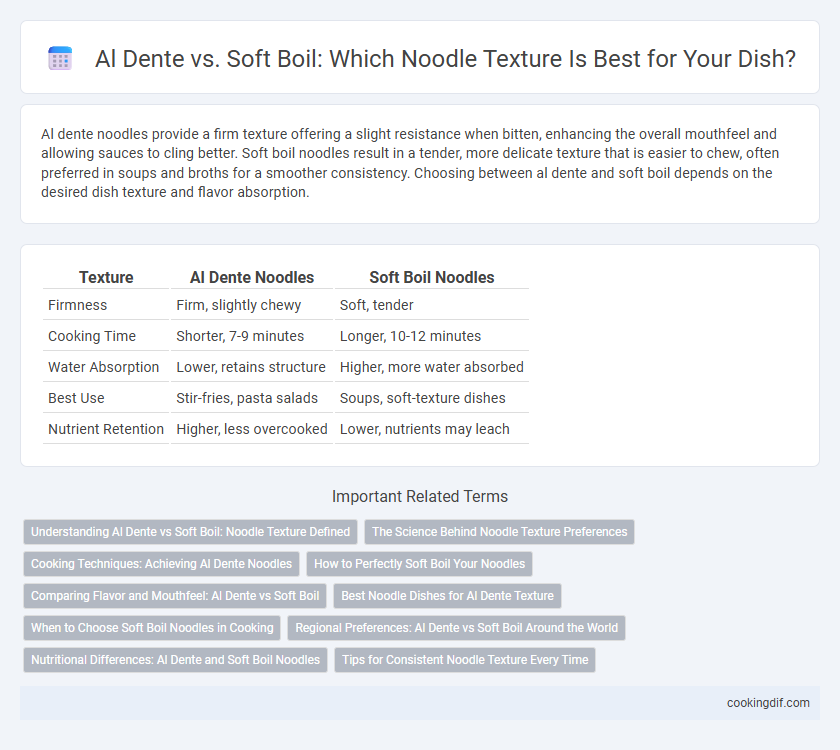Al dente noodles provide a firm texture offering a slight resistance when bitten, enhancing the overall mouthfeel and allowing sauces to cling better. Soft boil noodles result in a tender, more delicate texture that is easier to chew, often preferred in soups and broths for a smoother consistency. Choosing between al dente and soft boil depends on the desired dish texture and flavor absorption.
Table of Comparison
| Texture | Al Dente Noodles | Soft Boil Noodles |
|---|---|---|
| Firmness | Firm, slightly chewy | Soft, tender |
| Cooking Time | Shorter, 7-9 minutes | Longer, 10-12 minutes |
| Water Absorption | Lower, retains structure | Higher, more water absorbed |
| Best Use | Stir-fries, pasta salads | Soups, soft-texture dishes |
| Nutrient Retention | Higher, less overcooked | Lower, nutrients may leach |
Understanding Al Dente vs Soft Boil: Noodle Texture Defined
Al dente noodles offer a firm, slightly chewy texture that retains structural integrity during cooking, creating a satisfying bite preferred in Italian cuisine. Soft boil noodles are cooked longer, resulting in a tender, smooth texture that easily absorbs sauces and flavors, common in Asian dishes. Choosing between al dente and soft boil impacts the overall mouthfeel and flavor absorption, influencing the dish's authenticity and dining experience.
The Science Behind Noodle Texture Preferences
Noodle texture preferences hinge on starch gelatinization and protein matrix formation during cooking, with al dente noodles exhibiting partial gelatinization that preserves firmness and chewiness. Soft-boiled noodles undergo complete starch gelatinization, resulting in a tender, pliable texture that increases water absorption and surface stickiness. The balance of amylose and amylopectin in wheat starch influences these textural differences, affecting digestibility and sensory perception.
Cooking Techniques: Achieving Al Dente Noodles
Achieving al dente noodles requires precise timing and quick cooling to halt the cooking process, preserving a firm texture with a slight bite. Using plenty of boiling water and frequent stirring prevents sticking and ensures even cooking, while draining promptly maintains the ideal firmness. Soft boil noodles, by contrast, are cooked longer, resulting in a tender, less structured texture preferred in soups or softer dishes.
How to Perfectly Soft Boil Your Noodles
To perfectly soft boil your noodles, use plenty of boiling water and add a pinch of salt to enhance texture and flavor. Cook the noodles for 1-2 minutes longer than al dente, stirring occasionally to prevent sticking. Drain immediately and rinse with warm water to stop the cooking process while maintaining a tender, smooth bite ideal for soups and stir-fries.
Comparing Flavor and Mouthfeel: Al Dente vs Soft Boil
Al dente noodles offer a firm, slightly chewy texture that enhances flavor retention and provides a satisfying bite, making them ideal for dishes where noodle integrity is key. Soft-boiled noodles, by contrast, present a tender, smooth mouthfeel that allows sauces and broths to meld seamlessly, resulting in a more cohesive flavor experience. The choice between al dente and soft boil impacts not only texture but also how flavors interact with the noodle, influencing the overall dining perception.
Best Noodle Dishes for Al Dente Texture
Al dente noodles offer a firm, slightly chewy texture that enhances the overall bite of classic pasta dishes like Spaghetti Carbonara and Penne Arrabbiata. This precise cooking method preserves noodle integrity, preventing sogginess and allowing sauces to cling effectively. Popular recipes such as Fettuccine Alfredo and Pesto Genovese benefit from al dente noodles, highlighting their ideal balance between tenderness and resistance.
When to Choose Soft Boil Noodles in Cooking
Soft boil noodles are ideal when preparing dishes that require a tender, comforting texture, such as soups, casseroles, or stir-fries where noodles absorb flavors and blend seamlessly with other ingredients. Choosing soft boil ensures the noodles remain pliable, enhancing mouthfeel and preventing undercooked hardness that disrupts the dish's balance. For recipes emphasizing chewiness or structural integrity, like pasta salads or Asian cold noodle dishes, al dente texture remains preferable.
Regional Preferences: Al Dente vs Soft Boil Around the World
Regional preferences for noodle texture vary significantly, with al dente favored in Italian and some East Asian cuisines for its firm, chewy bite that enhances sauce absorption. In contrast, many Southeast Asian countries and parts of China prefer soft boil noodles, prized for their tender and smooth consistency that complements brothy dishes. These textural choices reflect cultural taste profiles and cooking traditions, influencing noodle preparation and consumption globally.
Nutritional Differences: Al Dente and Soft Boil Noodles
Al dente noodles retain more resistant starch, which aids in blood sugar regulation and contributes to longer satiety compared to soft boiled noodles. Soft boiled noodles have a higher glycemic index due to increased starch gelatinization, leading to quicker digestion and faster glucose absorption. Cooking noodles al dente preserves more nutrients, such as B vitamins, which can degrade with prolonged cooking times in soft boiling.
Tips for Consistent Noodle Texture Every Time
Achieving consistent noodle texture requires precise timing and water temperature control; cook noodles al dente for a firm bite or soft boil for tenderness based on the dish. Use a large pot with plenty of boiling water and stir noodles occasionally to prevent sticking. Quickly drain and rinse with cold water to halt cooking and maintain the desired texture.
Al dente vs soft boil for noodle texture Infographic

 cookingdif.com
cookingdif.com